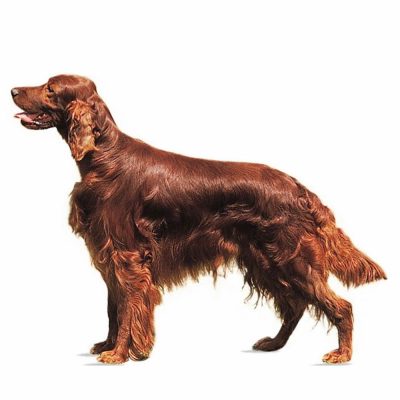Irish Setter
Group 3: Gun dogs
Height: 63 – 69 cm
Energy Level: Moderate to high
Original Function: Setting, retrieving
Lifespan: 10 – 15 yrs
Recommended for: Active people & families.

Group 3: Gun dogs
Height: 63 – 69 cm
Energy Level: Moderate to high
Original Function: Setting, retrieving
Lifespan: 10 – 15 yrs
Recommended for: Active people & families.

The Irish Setter’s ancestry involves the English Setter and the Gordon Setters. The red and white variety is less popular than the red Irish setter; this is why they are sometimes known as the Red setter. Setters were breed to “set” or locate game birds and then remain still while the hunter shot or netted the birds.
This breed is full of energy and high in spirits. They are very affectionate sometimes overbearingly so. They can be a challenge to train, early obedience training is a must in order to get this dog to come back if it ever gets off the lead. Being a hunter, although an easily distracted one, it will follow a scent all over if not trained to come back to its owner. With patience and kindness, The Irish Setter is easy to train and can even compete in obedience trials.
It is a sensitive breed though and will not respond well to harsh correction. This breed matures slowly, both physically and mentally and should never be pushed too far too fast. They are hard headed, stubborn and independent.
The Irish Setter plays enthusiastically but gently with children and is extraordinarily sweet and affectionate as a pet. They get on well with other dogs but do need early exposure to cats and other pets in order to live in peace with them.
If bored they are known to bark to excess so it is best to keep them happy and active.
Appearance: Must be racy, balanced and full of quality. Large sized body. Eyes dark. Ears long & hang to the side of the head. Tail coated & long.
Temperament: Highly affectionate and intelligent, they are good with children. Irish Setters must be trained at an early age to prevent the development of bad habits. They are wonderful dogs and considered as a joy to own.
Characteristics: Most handsome and refined in looks, tremendously active with untiring readiness to range and hunt under any conditions.
Colour: Rich chestnut with no trace of black. White on chest, throat, chin or toes, or small star on forehead or narrow streak or blaze on nose or face not to disqualify.
Coat: On head, front of legs and tips of ears, short and fine, on all other parts of body and legs of moderate length, flat and as free as possible from curl or wave. Feathers on upper portion of ears long and silky; on back of fore and hindlegs long and fine. Fair amount of hair on belly, forming a nice fringe which may extend on chest and throat. Feet well feathered between toes. Tail to have fringe of moderately long hair decreasing in length as it approaches point. All feathering to be as straight and flat as possible.
Grooming: Daily brushing is required to keep the coat in looking good. Check ears regularly for infections.
Exercise: plenty of exercise is needed, daily walks and off lead running. This dog was bred to hunt birds and is thus very active.
Health: This breed is generally sound but some can be prone to bloat, eye problems, hip and elbow dysplasia and epilepsy.